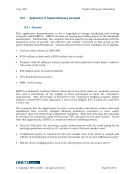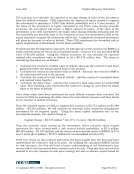June 2007 Capital Adequacy Extension © Copyright 2007, CCRO. All rights reserved. Page 82 of 92 one or more agents within a software model to invoke dynamic decisions and their consequences. Each time period the agent collects whatever new information is needed and available, applies its rules to that information, and responds with subsequent, necessary actions. By emulating a manager with this process, she described how one is able to encapsulate decision-making and its consequential actions inside a simulation model. In summary, the CRO characterized the agent based approach as being ideal for modeling assets or portfolios that must adjust over time to a changing environment – very much in line with their company’s business. Before recommending this to the company’s executives, the CRO wanted to address the area of utilizing a specific simulation tool to handle the agent based model. She mentioned that due to the complexities of the model, they would have to look beyond typical spreadsheet models such as @Risk or Crystal Ball to run this model. This would include evaluating both the company’s in-house model developers and external agent based modeling firms in order to secure the appropriate resources for this project. The CRO felt confident that she and the committee that would be put together could evaluate these options and move forward with a successful implementation of the agent based modeling project. 10.2.4. EMTCo Parameters for Agent Based Modeling The agent-based modeling recommendation was accepted unanimously and a committee was put together, lead by the CRO, to manage the agent based modeling project. The committee quickly realized that in order to understand the company’s future equity and financial liquidity requirements, it was imperative to understand the major risks faced by the firm, the interactions between risk groups, and the potential financial impact of these risks over the 5 year time horizon. The Committee identified the major risks as follows: • Market Risk – Changes in power prices and interest rates • Credit Risk – Potential defaults by counterparties • Operative Risk – Plant outages creating price spikes • Business Risk – Growth in new sales customers In order for the agent based model to be effective, a simulation would be required of all the firm’s functions inherent within the company’s operations that impacted future earnings and cash flows. The Committee specifically identified the need to simulate the following functions: • Sell contractual power to customers • Generate new customer deals • Price deals based on risks, forward prices, and volume uncertainty
Purchased by unknown, nofirst nolast From: CCRO Library (library.ccro.org)




























































































